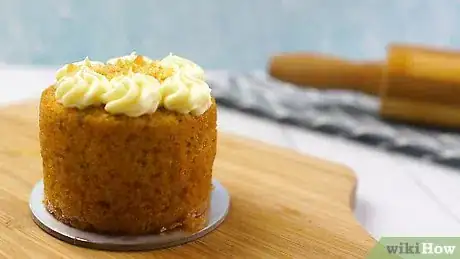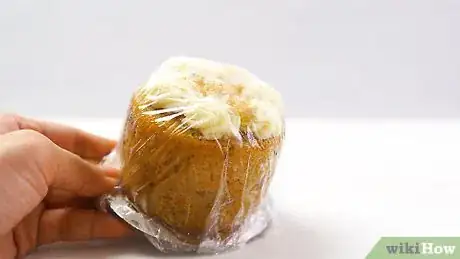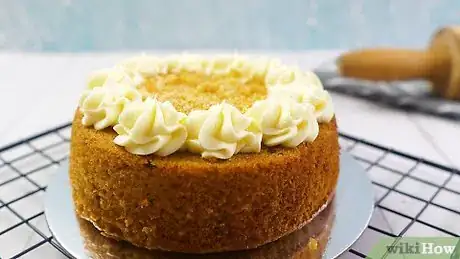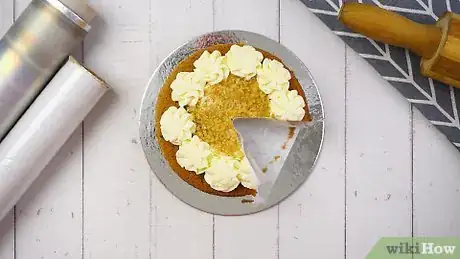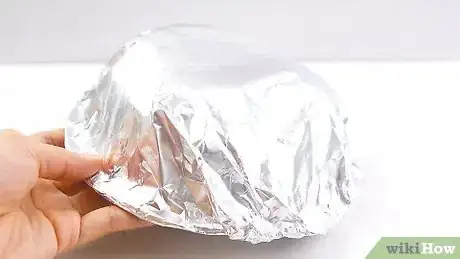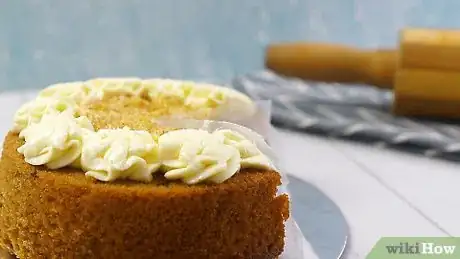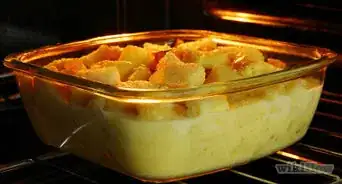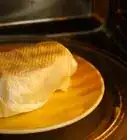This article was co-authored by wikiHow Staff. Our trained team of editors and researchers validate articles for accuracy and comprehensiveness. wikiHow's Content Management Team carefully monitors the work from our editorial staff to ensure that each article is backed by trusted research and meets our high quality standards.
There are 11 references cited in this article, which can be found at the bottom of the page.
The wikiHow Video Team also followed the article's instructions and verified that they work.
This article has been viewed 25,986 times.
Learn more...
Whether you’re whipping up a homemade carrot cake a day or two ahead of a big event or trying to figure out what to do with the leftovers afterwards, it can be helpful to know how to get your confection to keep for as long as possible. While other types of cakes will generally be okay out on the countertop for a few days, the best place to store a carrot cake—and any other cake with cream cheese frosting, for that matter—is the refrigerator. There, it should stay good for up to a week.
Steps
Refrigerating Your Cake
-
1Plan on refrigerating your cake if it’s particularly warm in your kitchen. It’s usually alright to leave most kinds of cakes, including carrot cake, sitting out at room temperature, no longer than they tend to last. If you live somewhere with a hot or humid climate or have trouble keeping your kitchen cool, however, you may be better off choosing the refrigerator as your go-to storage solution.[1]
- Consider stashing your cake in the refrigerator if the temperature in your kitchen is higher than about 70 °F (21 °C) at any given time.[2]
- Heat and moisture are like an open invitation to harmful bacteria, especially where there’s also plenty of sugar to feed on.
-
2Seal up the cake in a sheet of plastic wrap. Tear off a piece of plastic big enough to fit over the entire piece or uneaten portion. If you’re storing a whole cake, you may need to use more than one sheet. Just be sure to check the wrapping for gaps or loose edges when you’re done.[3]
- Alternatively, you can wrap your carrot cake with a sheet of wax paper or aluminum foil, or cover it with a cake keeper or upside-down bowl.[4]
- Some baking gurus recommend chilling frosted cakes for about 15 minutes prior to wrapping them to allow the icing to harden. This may help you avoid making a mess when the time comes to remove the plastic, wax paper, or foil.
Tip: It’s always a good idea to cover cakes that are destined for the fridge, even if you haven’t cut them yet. Otherwise, they may absorb unpleasant odors from whatever else is lurking in there.
Advertisement -
3Place the cake in your refrigerator and leave it for up to one week. You should have no trouble finding room for one or two single slices. For whole cakes, sheet cakes, or remnants left over in large pans, try to clear a hole near the back or corner of one of your shelves, away from any items that might cause cosmetic damage if they happen to fall over.[5]
- Once your cake is safely tucked away in the refrigerator, avoid taking it out again until you’re ready to serve it. Repeated changes in temperature could cause it to go bad faster.
-
4Remove the cake from the fridge 1-2 hours before enjoying it. Just transfer the cake to your countertop and allow it to sit while you go about your business. This will give both the frosting and the cake beneath time to reach room temperature, preventing any weird inconsistencies in texture.[6]
- If you intend to serve your carrot cake for dessert, simply take it out of the refrigerator right before you sit down for your main course.
- Unwrapping or uncovering your cake will help it warm up a little quicker.[7]
Storing Your Cake at Room Temperature
-
1Keep frosted, uncut cakes out on your countertop for 2-3 days. If you’ve already iced your carrot cake but have yet to slice it, there’s no need to resort to any special storage tricks. The frosting itself will act as a kind of barrier to keep out unwanted environmental bacteria. Even cakes coated with cream cheese frosting will do alright on the countertop for a couple of days, provided they don’t get too warm.[8]
- A thick layer of frosting can often be enough to protect a cake on its own, since it takes a while for sugar to spoil.
- Though your cake won’t be in danger of becoming stale, you may still want to cover it with a cake keeper or overturned bowl to make sure that dust, pet hair, and other types of debris don’t find their way onto the outside.[9]
-
2Cover the exposed parts of cut cakes with wax paper or more frosting. Let’s say you’ve gone ahead and helped yourself to a slice but want to save the rest for later. In this case, either press a sheet of plastic wrap or a folded piece of wax paper into the wedge-shaped empty space or simply spread some fresh frosting onto the sliced edges.[10]
- With the exposed edges covered, your cake should do just as well at room temperature as if it had never been cut.
- One downside of re-frosting a cake that’s already been cut is that it increases the total amount of sugar and fats grams in the confection. Keep this in mind if you’re counting calories.[11]
Tip: For maximum freshness, combine your wrapping material of choice with a cake keeper or similar cover.
-
3Double-wrap unfrosted cake layers to make them airtight. Bundle each layer in one or more sheets of plastic wrap, then seal the wrapped layers inside large plastic zipper bags individually. By doing so, you’ll be keeping the freshly-baked cake off-limits to air and moisture.[12]
- Cake layers stored this way can easily last for up to 5 days, or possibly even longer.
- You can also freeze unfrosted cake layers with no ill effects for 6-12 months.[13]
- This method can come in handy in those situations where you want to go ahead and get your baking out of the way and take care of the icing at a later time.
Freezing Your Cake
-
1Freeze your cake if you need to store it for longer than a few days. You may not know it, but cake freezes surprisingly well. Whereas a well-wrapped or frosted cake will last 2-3 days out on the countertop and about a week in the fridge, a properly frozen cake will remain edible for upwards of a year![14]
- Although a carrot cake can easily survive a full trip around the sun in the freezer, it may begin slowly losing some of its pizzazz after about 3 months.[15]
-
2Wrap the cake in both plastic wrap and aluminum foil for improved protection. You can also seal it up in a lidded food storage container, if you prefer. Either method will work just fine, as long as you ensure that it's as airtight as possible. Take an extra moment to check for holes, gaps, or loose sections in the plastic or foil.[16]
- You also have the option of wrapping your cake and putting it in a separate container if you don't want to take any chances where freezer burn is concerned.[17]
- The key to freezing a cake without destroying its light, fluffy texture is to keep out environmental moisture at all costs.
Tip: Don't forget to label your cake and make a note of the freezing date so you'll know at a glance what it is and how long it's been in storage.
-
3Make some room for the cake in your freezer. Perch individual slices on top of ice trays, frozen dinners, cans, jars, and other weighty items that may threaten to crush them. It may be necessary to rearrange a few things if you're putting away a whole cake.[18]
- Consider using a small tray, serving dish, or sturdy baking sheet to stabilize your cake and keep it from leaning, sliding, or shifting.
-
4Let your cake thaw for 20-30 minutes before you dig in. When it's time to retrieve your cake from cold storage, move it to the countertop, uncover it or unwrap the outermost layer of material, and allow it to sit for around half an hour. This should be just enough time for it to soften up and reach a good temperature for eating.[19]
- Whole cakes may need closer to an hour to defrost completely.[20]
- If you're in a hurry, speed-thaw single slices by microwaving them in 15-20 second intervals on a low temperature setting.
Warnings
- Consuming dairy-filled baked goods once they’re past their prime could result in nausea, vomiting, diarrhea, abdominal cramps, mild headache or fever, or other unpleasant symptoms.[21]⧼thumbs_response⧽
Things You’ll Need
Refrigerating Your Cake
- Refrigerator
- Plastic wrap
- Wax paper or aluminum foil (optional)
- Cake keeper or large bowl (optional)
Storing Your Cake at Room Temperature
- Plastic wrap or wax paper
- Cake keeper or large bowl
- Large plastic zipper bag
Freezing Your Cake
- Freezer
- Plastic wrap
- Aluminum foil
- Large, lidded food storage container (optional)
- Small tray, serving dish, or sturdy baking sheet (optional)
- Felt-tipped marker (optional—for labeling)
References
- ↑ https://www.thekitchn.com/expert-advice-how-to-wrap-stor-151924
- ↑ https://www.cookinglight.com/eating-smart/smart-choices/do-i-need-to-refrigerate-cream-cheese-frosting
- ↑ https://www.thekitchn.com/expert-advice-how-to-wrap-stor-151924
- ↑ https://www.southernliving.com/desserts/cakes/how-to-store-cake
- ↑ https://www.stilltasty.com/fooditems/index/16695
- ↑ https://www.foodnetwork.com/fn-dish/how-to/2011/10/cream-cheese-frosting-refrigeration
- ↑ https://www.thekitchn.com/expert-advice-how-to-wrap-stor-151924
- ↑ https://www.thekitchn.com/expert-advice-how-to-wrap-stor-151924
- ↑ https://www.cookinglight.com/eating-smart/smart-choices/do-i-need-to-refrigerate-cream-cheese-frosting
- ↑ https://www.southernliving.com/desserts/cakes/how-to-store-cake
- ↑ https://www.cookinglight.com/eating-smart/smart-choices/do-i-need-to-refrigerate-cream-cheese-frosting
- ↑ https://www.southernliving.com/desserts/cakes/how-to-store-cake
- ↑ https://sallysbakingaddiction.com/how-to-freeze-cakes/
- ↑ https://www.bonappetit.com/test-kitchen/cooking-tips/article/the-rules-of-freezing-cake
- ↑ https://brooklynfarmgirl.com/how-to-freeze-cake/
- ↑ https://www.thekitchn.com/can-i-freeze-a-fullydecorated-138328
- ↑ https://sallysbakingaddiction.com/how-to-freeze-cakes/
- ↑ https://www.thekitchn.com/can-i-freeze-a-fullydecorated-138328
- ↑ https://www.bonappetit.com/test-kitchen/cooking-tips/article/the-rules-of-freezing-cake
- ↑ https://www.southernliving.com/food/how-to/how-to-freeze-cake-video
- ↑ https://healthcare.utah.edu/the-scope/shows.php?shows=0_kjy3yjer
